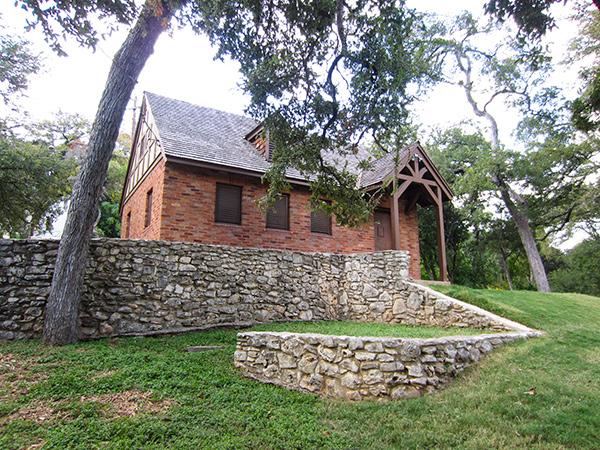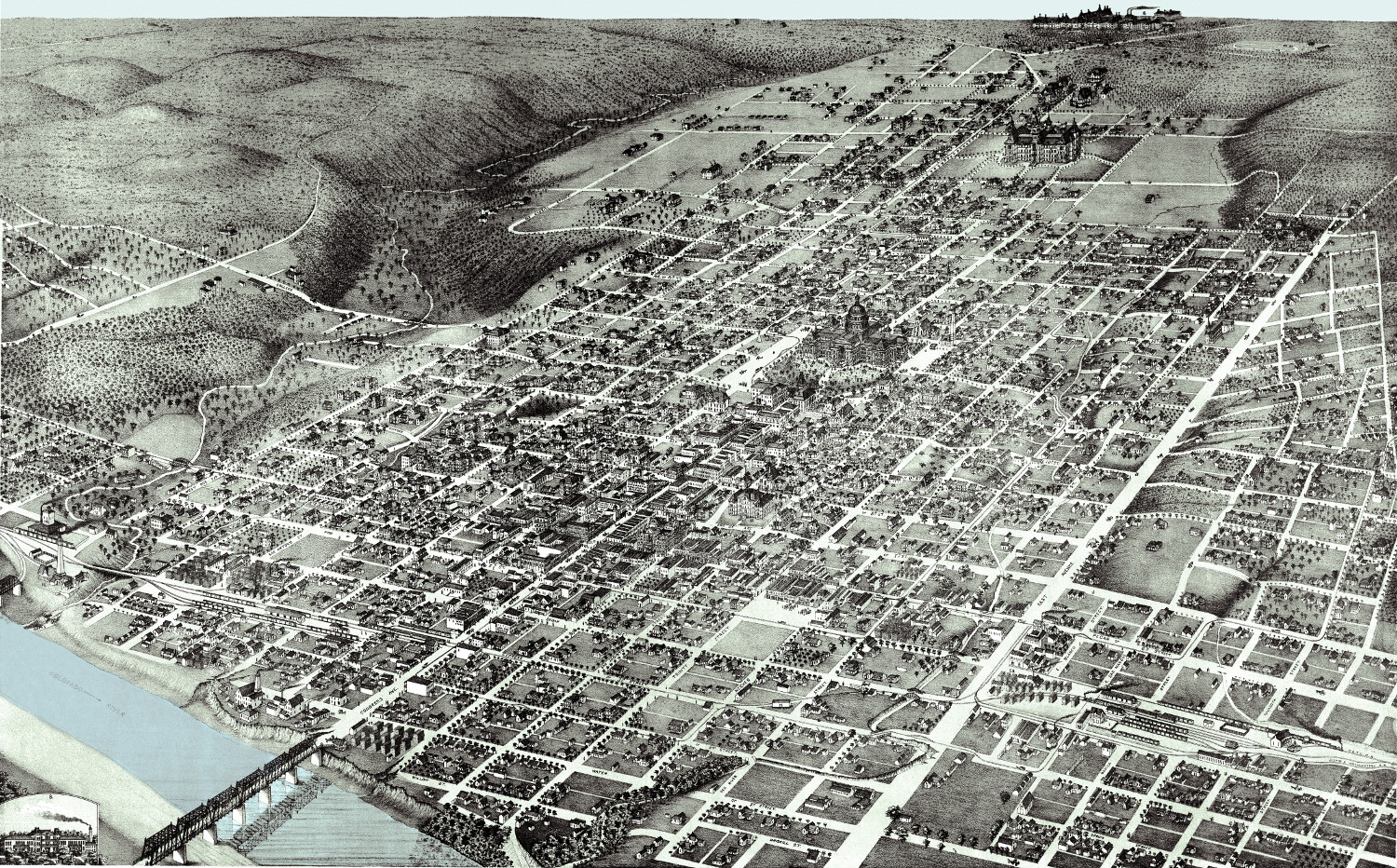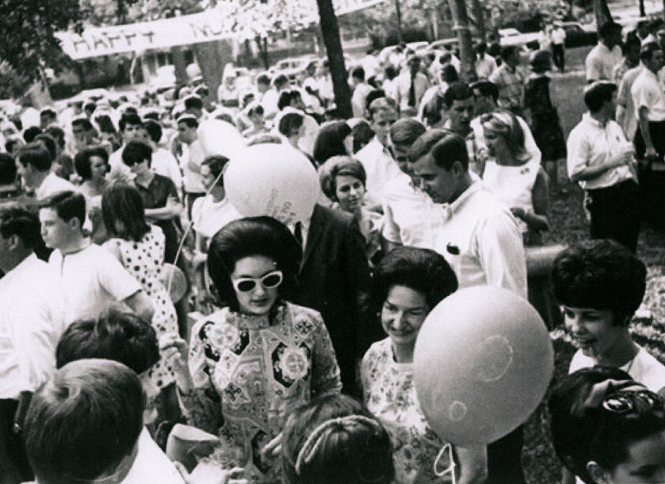Pease Park is Austin’s first public park. This land has a storied history-- one holding both joy and pain.
The site of today’s Pease District Park was part of the 365-acre Woodlawn homestead owned by former Texas Governor Elisha M. Pease and his wife Lucadia. Their 1853 house of the same name still sits two blocks west of the park’s boundary today. Governor Pease and his wife acquired it in 1857.
State Historical Survey Committee sign in Kingsbury Commons
Originally from Enfield, Connecticut, the 23-year-old Pease moved to Texas in 1835. He was an attorney and soon became active in the Texas Independence movement. He held several offices in the new Republic of Texas government, including serving as Texas Comptroller. After Texas was annexed to the Union in 1845, he served in both the Texas House and Senate, representing Brazoria and Galveston counties.
Pease went on to be elected Governor in 1853 and 1855. He is remembered both as a progressive-- the father of Texas public education who laid the financial foundation for the state’s schools and colleges-- and as a fiscal conservative, who paid off the state’s debts.
Although Governor Pease supported the Union cause during the Civil War, he was an enslaver. Research has found that more than 37 unique individuals were directly enslaved or leased as enslaved labor by Governor Pease. We want to recognize and honor these people who were forced into labor, many on this land that is now Pease Park, and share their stories and this history with the community. To learn about a few of the people who were enslaved here, we hope you will take one of the in-person Pease Park History tours or the self-guided tour. These tours will begin in the fall of 2025.
After the war, Union General Philip H. Sheridan appointed Pease as the civilian Governor of Texas during Reconstruction in 1867. Pease tried to steer a middle course between the more radical policies of some Republicans and his unreconstructed ex-Confederate fellow Texans. This proved an impossible task given the heated temperament of the times and he resigned in 1869.
Mrs. Pease had always enjoyed carriage rides along the banks of Shoal Creek below their house. She regarded it as the “prettiest part” of their property. The Pease family traveled back to Connecticut frequently to visit relatives and were aware of the development of Central Park in New York City and Prospect Park in Brooklyn. Public parks were being developed in cities all across the country after the Civil War as part of the nascent “City Beautiful” movement. Knowing that their land closest to Shoal Creek was not safe for habitation because of its propensity to flood, Governor and Mrs. Pease signed a deed donating 23 acres of land along Shoal Creek to the citizens of Austin “for use as a public park” on August 25, 1875.
Enslaved people labored on this land. Black washerwomen likely used the creek for their work while enslaved, and later used the same waters to find some economic autonomy post-emancipation. The area surrounding Shoal Creek likely served as an “urban commons” where Black children fished, swam, and experienced moments of joy as Black freedom communities were established throughout the city. But, over the next 50 years, restrictions such as a the 1928 City of Austin plan led to segregation in the City of Austin and exclusion of people of color from Pease Park.
En 1926, el Club Kiwanis de Austin se comprometió a embellecer el Parque Pease. El socio del club Frank Rundell, que vivió en Wooldridge Drive durante muchos años, fue el contratista general del proyecto. Según el Austin Statesman, se asignaron 4.500 dólares para un baño, 1.000 dólares para las puertas de entrada al monumento, 1.200 dólares para la piscina infantil y 1.600 dólares para una presa de agua baja.
Tudor Cottage prior to renovations
La cabaña Tudor
The old restroom, known as the Tudor Cottage is widely believed to have been designed by noted architecture firm, Giesecke and Harris. The Cottage is one of the earliest buildings constructed in Austin as a park facility. The restrooms were designed in the mid-1920s. Giesecke and Harris designed the Austin High School Annex and Lee Elementary, as well as the Merchants and Manufacturers Building in Houston.
El puente de la calle 24
The bridge was built in July 1928 in only 28 days to bring potential buyers across Shoal Creek to new neighborhoods. It incorporates a difficult decorative concrete technique and was declared one of the most beautiful bridges in Texas. In 1939, the bridge was widened to four lanes and was a Works Progress Administration (WPA) project stemming from the Great Depression. In 1988, the city planned to demolish the bridge to widen Windsor Road to six lanes, but many citizens, including US Senator Ralph Yarborough, lobbied to preserve the bridge and it was given protected historic landmark status that year.
Los filántropos
In 1952, Janet Long Fish, daughter of Austin community leader, Walter E. Long, had the idea that a walkthrough path along the roadbed of the old Comanche trail would help preserve the disappearing road, which ran from the shoal of the Colorado River up along Shoal Creek to 34th Street, where it crossed the creek and continued west and north into the hills.
She persuaded the Austin City Council to approve the construction of the hike and bike trail from Pease Park to 39th Street, spending her own money, time, and effort to get it done.
For four years, Fish led a bulldozer along the trail to grade it according to the City requirements. One day she disappeared into the 6-foot high ragweed. From then on, she threw her hat into the air every few steps so the bulldozer driver could follow her.
Since 1961, the City of Austin has maintained and patrolled the trail. Many other individuals, serving as volunteers for community service organizations, including the Junior League of Austin and the Austin Metro Trails and Greenways, have contributed time, effort, and money toward the preservation of Shoal Creek.
Aguas poco profundas
Shoal Creek was given its name by Edwin Waller, who used it as the western boundary of Austin while laying out the original townsite (called Waterloo) in 1839. A shoal is a place in any body of water where the water is especially shallow. This 9-mile intermittent stream is fed by natural underground springs and carries rainwater south to the Colorado River, emptying into Lady Bird Lake.
Historic map of Austin, created by Cartographer, Augustus Koch, in 1887
Fiesta de cumpleaños de Eeyore
Eeyore’s Birthday Party, started in 1963 as a spring party for the Department of English students at the University of Texas, has been hosted at Pease Park since the 1970s. The event was named for Eeyore, the chronically depressed donkey in A.A. Milne’s “Winnie the Pooh” stories. Eeyore believes his friends have forgotten his birthday, only to discover they have planned a special celebration for him. The party became a much-loved Austin tradition. It is organized by Friends of the Forrest Foundation and takes place on the last Saturday of April.
Eeyore’s Birthday Party in 1966, Austin American Statesman
Pease Park Conservancy
Trees for Pease was founded by Richard Craig in 2008 as a volunteer organization with the purpose of planting trees throughout the park. Since it is in a flood zone, repeated cycles of floods and droughts caused vegetation damage and disrepair. Trees for Pease grew and became Pease Park Conservancy (a 501(c)3) in 2013. The Pease Park Vision Plan was completed by the Conservancy and approved by the City of Austin in 2014. Because of a generous gift from the Moody Foundation and other donors, a substantial renovation based on that Vision Plan took place in Kingsbury Commons and was completed in the summer of 2021. Following this renovation, Pease Park Conservancy entered into a Park Operations and Maintenance Agreement (POMA) with the City of Austin to operate, maintain, and bring programming to Kingsbury Commons.
The Conservancy today works to make sure that Pease Park is a place where all feel welcome and where all Austinites can connect with one another and with nature.
Native Americans in this area
Archaeologists estimate that the earliest ancestors of the Native Americans were in Central Texas 11,400 years ago. Native American tribes wintered in Texas, and in the summer followed the bison herds north across the Great Plains. When Spanish and then American colonizers arrived in the 1700-1800s, Native American populations suffered substantial losses from disease and conflicts over land and natural resources. The Coahuiltecan people were the original habitants of the area now known as Austin and Central Texas. Later, the Tonkawa, Comanche, and Lipan Apache were known for their habitation here.





